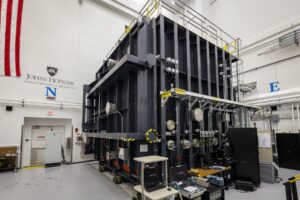The Johns Hopkins Applied Physics Laboratory (APL) in Laurel, Maryland has deployed its largest environmental simulator in preparation for NASA’s Dragonfly Mission to Saturn’s Moon Titan.
During the chamber’s recent inaugural run, a replica of the car-sized rotorcraft lander endured the extreme conditions of Saturn’s largest moon—reaching temperatures of minus 180 degrees Celsius in an atmosphere four times denser than Earth’s. The successful week-long test required 200 gallons of liquid nitrogen per hour for continuous simulation of Titan’s temperatures and atmospheric pressure.
While smaller test chambers have simulated Titan’s environment for Dragonfly’s systems and components, Dynavac’s approx. 3,000 cu. ft. chamber allows for testing on the full-scale thermal model of NASA’s nuclear-powered drone.
“Operation of the Titan Chamber is a significant milestone that advances our spaceflight development capability,” said Bobby Braun, head of APL’s Space Exploration Sector. “Created with internal investment funds, this facility is critical to making sure that a game-changing mission like Dragonfly is able to operate reliably in the exotic, alien environment of Titan. It also provides our teams with a cutting-edge resource to prepare a broad range of spacecraft for exploration of the extreme environments found in the outer solar system.”
After Dragonfly launches, APL will reconfigure the 165,000-pound chamber from temperature-altitude testing to a full thermal-vacuum system.
Images: NASA/Johns Hopkins APL/Ed Whitman

Full-scale rotorcraft thermal model in the Dynavac chamber

Titan environmental simulation chamber at JHU APL

System operator controlling the JHU APL Titan chamber via Dynavac HMI

